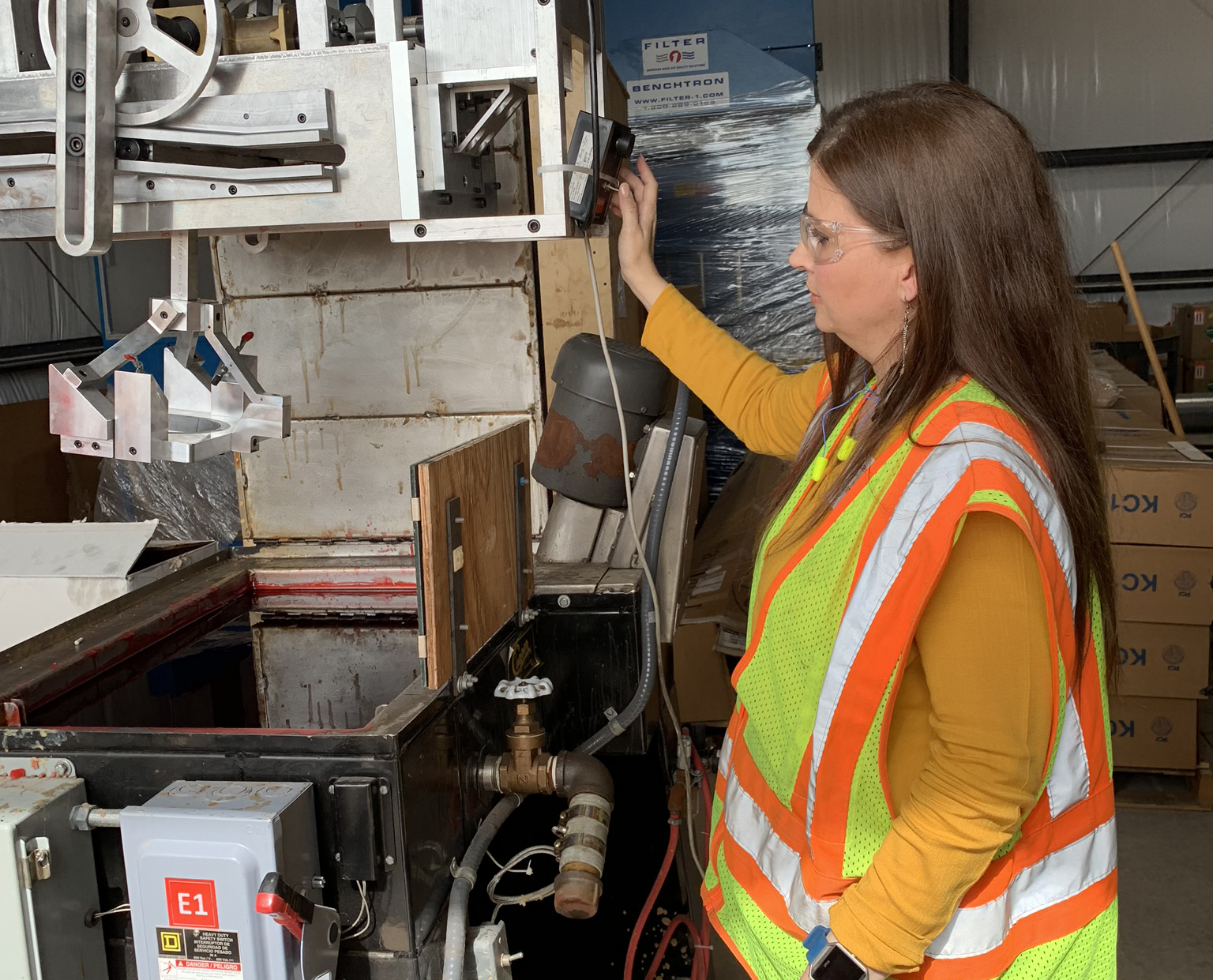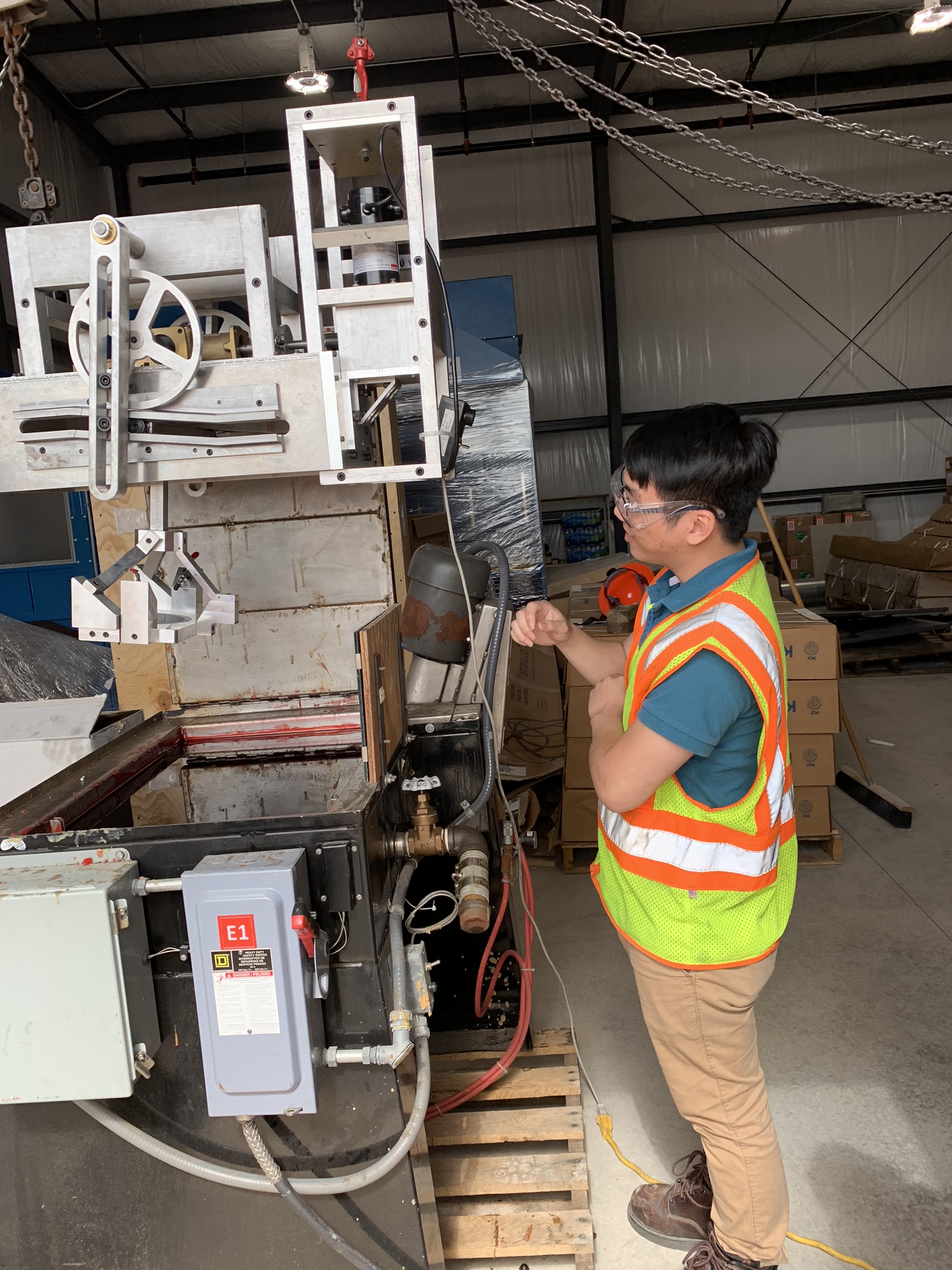Team learned a lot through a year of challenging situations
Julie Goforth wanted to embrace her senior design project. It wasn't just about finishing her final few credits and becoming a graduate, it was a chance to leave a lasting impression at Midwestern State. And a time to show the industrial world she was ready.
Khoa Tran needed a technical idea and then wanted to see it implemented before he walked across the graduation stage.
The McCoy School of Engineering seniors had an opportunity to do something special. Could they solve a real-life problem to help corporate partner Arconic in the future? And could they accomplish that in an affordable manner?
As a team, yes, they could. Goforth, Tran, and teammates Heather Goolsby and William Mendez used the many technical and personal skills they developed at Midwestern State to finish with a senior design success story. They designed a mechanism for parts to be dipped into hot wax to seal edges and protect metal during transport.
Previously an employee would have to hand-dip the items into molten wax and do so at an ergonomically-challenging angle which could cause physical strain and product reliability issues. An Arconic team, led by Chris Keating and Kentzie Rhodes, worked with the McCoy quartet to see the mission completed in May when they saw their design in operation.
"We learned quickly to communicate daily, sometimes throughout the day when it came closer to our deadlines," Goforth said.
"It was a great feeling (when it was finished)," Tran said. "All the hours and hard work we put into the project did not go waste in the end, and so, I felt very happy to see everything worked out as intended."
Senior design is a yearlong senior capstone class that emphasizes creative and critical thinking, planning, design, teamwork, and project management.
Dr. Salim Azzouz, Associate Professor of Engineering at MSU Texas, saw all those qualities and more on display with this group, working in unison with Arconic. He said it was the first project of this kind with the company, which operates an engineering and manufacturing plant for lightweight metals in Wichita Falls.
Getting students working with professionals in an industry is a goal of the class.
"Human interaction in any project is always a big part of the equation," Azzouz said. "In a project like this, there's always something to perfect. But how do we interact with each other? Sometimes you find people very difficult to interact with and some are very open to ideas."
It was also linking the past, present, and future at MSU Texas. Keating is a 1998 graduate and is a leader for continued improvement at Arconic. "He was a problem solver," Azzouz said. "Tremendous! He's very easy to work with, very approachable. He was the one who made everything work."

RISING TO THE OCCASION
Goforth felt the biggest challenge was logistics. At times the group spent one week at Arconic followed by a week on campus. "Because Arconic produces aero engine components using a proprietary process, it was necessary for us to visit the plant and take back with us very little information that we could share. Determining what we could draw on our boards or discuss at school was a challenge. We eventually had engineers from Arconic come to MSU once a week during the final stages of design because the machine had become so complex."
"Julie was really the link," Azzouz said. "She works as an intern at Arconic, and she did tremendous work of coordinating between us and Arconic. The students designed the whole machine with supervision and oversight."
Goforth said Tran came up with the concept for the quick return mechanism. Tran felt some pressure in the beginning, but he rose to the occasion.
"My biggest challenge was coming up with the idea for the parts, and then, implementing that idea into the design during the brainstorming phase and designing phase," Tran said. "Because of my limited experience with the real-world machining process, I struggled when designing parts for the machine. Some parts were impossible to machine due to the complexity of their shape. It was a difficult challenge."
It took time and teamwork. And patience. But there was a pay-off, Goforth said.
"Because our design phase had taken so much of the second semester, we came down to the last week of the semester before the machine was built and assembled," Goforth said.
"This experience was quite similar to how a team works in the real world, so it definitely made me feel more prepared for life after college," Tran said.
IT TAKES A TEAM
"I want to thank my professor, Dr. Salim Azzouz, for his never-ending support and involvement in this project," Goforth said. "He encouraged us, challenged us and taught us to be professional and accountable throughout this project."
And the group proved to make it affordable, too, coming in at $4,300 below the original cost projection.
"I would like to thank Arconic for bringing us this project and all the support they have provided us during the project," Tran said. "I also wanted to thank Dr. Azzouz for his guidance and advice during the project. And finally, I wanted to thank everyone on our team for putting aside the disagreements and differences to make this project a success. It was a wonderful experience, and I'm glad to be a part of it."
Q&A
Selected questions and answers from the McCoy School of Engineering/Arconic wax dipping machine senior design project.
Q: What was the teamwork like and does it make you feel more prepared for life after college?
Goforth: As addressed before, the team became the four of us students and two engineers from Arconic and after parts were ordered and delivered to Arconic for machining, the team included their design team and machinists and electrical engineers. We learned quickly to communicate daily, sometimes throughout the day when it came closer to our deadlines.
I learned how to schedule, coordinate meetings and invaluable communication skills throughout this project. This will be an asset for my current job I just started after graduation as an assistant project manager for the local construction company, FG Haggerty.
Tran: The teamwork was great. We had some disagreements here and there. Miscommunication also occurred between our team and the Arconic sometimes. But after all, we reached out to each other, made some compromises, and then pushed the project forward together. This experience was quite similar to how a team works in the real-world so it definitely made me feel more prepared for life after college.

Q: Your feelings when you realized everything was going to work out and it was a major success?
Goforth: Because our design phase had taken so much of the second semester, we came down to the last week of the semester before the machine was built and assembled. When we finally had the chance to go see the machine mounted and functional, I felt like we had accomplished something that very few people in a college setting will ever experience. To have been given a task this paramount with such a limited time in which to complete seemed daunting at first. But in the end, we created a machine that is an actual working mechanism that will be incorporated into a proprietary process for a multi-billion dollar company. I'm very proud of my group, to say the least.
Tran: It was a great feeling! All the hours and hard-work that we put into the project did not go to waste in the end, and so, I felt very happy to see everything worked out as intended.
Q: Advice for young students going into the McCoy College of Science, Mathematics and Engineering?
Goforth: My advice for new McCoy Students is to learn everything you can in your four years at MSU. Give your instructors your full attention when they speak. Take notes and absorb everything you are taught, not just for your tests and finals, but for your permanent knowledge. The pinnacle of your engineering education will occur during senior design. Every class you have taken will come in to play during your last year. Giving presentations of your project will force you to know your project inside and out and will prepare you for your future career. Get an engineering internship! It's vital for future employers looking at your resume to see that you have experience. Treat each week as if it's you're last week in McCoy and don't take one second for granted. And lastly, be a lifelong learner. Education does not stop once you cross the stage at graduation. Always strive for more knowledge. It's a powerful thing.
Tran: Study hard. Keep it simple when designing things. Learn more about machining process. And don't give up. It will be a difficult road but it will be worth it.
Q: Did this experience already set up a job opportunity?
Goforth: I've taken taken a job as assistant project manager for FG Haggerty, a local construction company. I want to thank my professor, Dr. Salim Azzouz for his never-ending support and involvement in this project. He encouraged us, challenged us and taught us to be professional and accountable throughout this project. I also want to give credit to Khoa Tran for coming up with the concept of a quick return mechanism that the entire machine was built around.
Senior design projects 2018-19
Study of Deflection in GPHE products under hydro-static pressure (Brian Blair, Joseph Munholland, Chenai Sukume, Xiao Chengxiang)
Measure loop systems for material flows and power transmissions (Blake Jenkins, Timothy Jones, Grantley Samuels, Zachary Voohies)
Mobile wireless surveillance systems with unpredictable coherent motions (Virgil Henry, Darrell Middelsworth, Mamgoree Sock, Juwel Williams)
Automated pencil sharpening robotic work cell (Afolabi Adereti, Aaron Calvert, Jedeshkeran Chandrasegaran, Parth Sagpariya)
Pneumatic pick and place servo robot using a programmable logic controller (Akech Frankline, Mi'Kyle Percentie, Jenom Pyeng, Bryan Rutledge)
A bionic robot hand with force feedback (Nchetachukwu Anih, Chance Craig, Dieonna George, Kenneth Griffin)
Design and implementation of a bionic robot arm (Omar Clarke, Jomarie Leblanc, Michael Sweeting, Nicholas Wolf)
A pulley based movable apparatus for the biology department (Johnny Cognasi, Jason Perkins, Joseph Randall, Melanie Ronoh)
Multi-phase flow performance in the wellbore (Abdulhadi Alsadi, Tapiwa Gasseler, Till Gebel, Abigail Ryes)
A wax dipping machine (Julie Goforth, Heather Goolsby, William Mendez, Khoa Tran)
(Photo by Kentzie Rhodes) From left to right, Chris Keating, William Mendez, Jerry Miles, Julie Goforth, Khoa Tran, Heather Goolsby, Dr. Salim Azzouz, Mike Kwas, and D.R. Shed.
